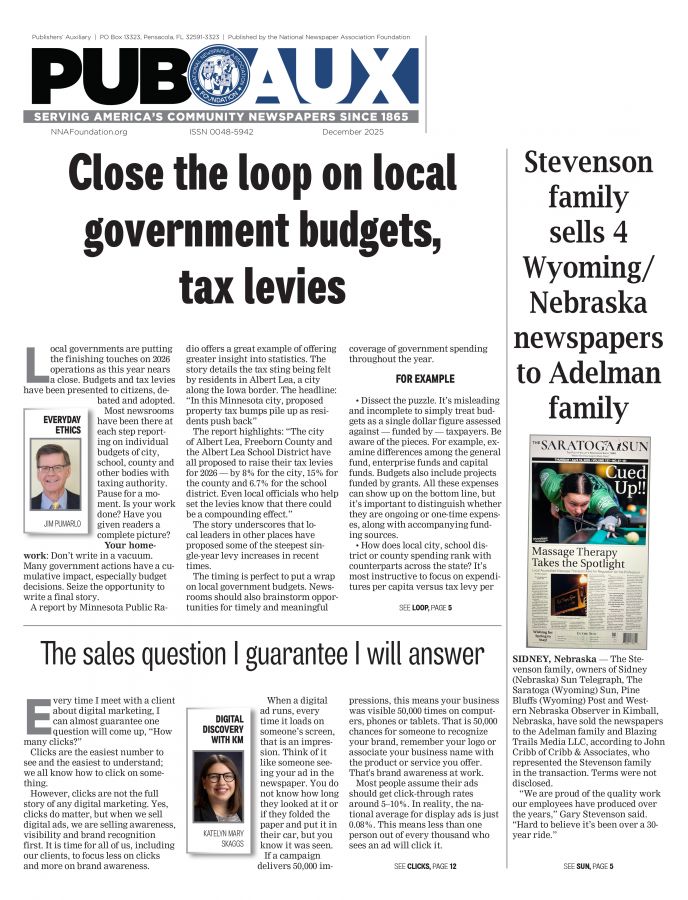Statement of John Galer, chair of the NNA and publisher of The Journal-News, Hillsboro, Illinois
Apr 16, 2024


on behalf of NNA for the Oversight of the USPS Hearing Committee on Homeland Security & Governmental Affairs
Chairman Peters, Ranking
Member Paul, and members of the Committee:
The National Newspaper Association is a non-profit newspaper trade association founded in 1885. The organization has over 1,700 members, making it the largest newspaper trade association in the United States. Our members are the watchdogs in communities across the nation and are part of the small business infrastructure in their cities and towns.
As a newspaper publisher and longtime NNA member, I want to start by saying service issues with USPS have always been complicated, but now in 2024, things have gotten worse. Mailing through regional or other distribution centers with USPS guarantees slow delivery.
Most of my eight newspapers in central Illinois work through St. Louis, where there are serious problems getting periodicals out in a timely fashion. We truck and deliver directly to post offices in two counties to ensure that those papers get out the same day, dropping off many at 5 a.m. Our subscribers get their newspapers on time when we do the trucking.
The rate increases continue to hamper growth in subscription numbers. When the post office started the twice a year gouging, we absorbed it and limited subscription price increases for our subscribers. Unfortunately, we now must pass on those rate hikes completely if we want to keep people working for us in the newsroom.
Two of our total market coverage products (which we use to reach every household on behalf of our local merchants) have had to close this past year because of the price increases in Marketing Mail. Our TMCs were built to serve grocery stores and their consumers, but few stores can now afford to pay the hefty increased rates. With our destination delivery unit in-county mail, the TMC products represent the easiest and least costly products USPS ever handles, and yet the rate increases continue to soar. One big loser here is the destination post office, which has lost a lot of business.
We deliver the TMCs and our newspapers directly to the local post offices so there is no USPS transportation. They are prepared in a simplified address format. Postal carriers do not even case them; they just take our bundles load them into the truck and grab a handful to deliver as they walk the route.
The USPS is losing money as it loses customers like my publications. The model of providing increasingly poor service while increasing rates is not sustainable.
NNA therefore urges Congress to consider actions to:
- Update and modernize the postal regulatory process to better safeguard against excessive rates and poor service
- Compel accurate measurement of newspaper service and hold the USPS accountable for maintaining and improving service quality
- Limit rate increases for in-county newspaper delivery to 50% of the CPI-U to permit the industry to recover from the recent deluge of above–inflation increases
- Urge the PRC to postpone the nearly 10% increase scheduled for July to assess the impact on volume, USPS data quality and the impact this increase could have in driving a terminal loss of volume
Along with this statement, I am including letters outlining difficulties for two NNA members: Eric Hamp, who is the publisher of the Houghton Lake Resorter and Roscommon County Herald News in Michigan, and Regina A. Catlett, publisher of the Sebree Banner and Sturgis News in Kentucky. These two are just a sample of the stories we hear at NNA every day. Also included is a graphic outlining response on questions regarding postal issues to our entire membership.
NNA applauds you for holding this hearing to provide oversight of USPS and to question its leadership about the persistent financial losses of USPS — which were more than $6 billion in 2023 and may be even larger in 2024 — and the lack of progress toward USPS sustainability under the Delivering for America plan.
NNA is collaborating with members of Congress to require more accountability through improved regulation and data gathering. We are glad to note that the PRC has decided to advance the next review of the rate-setting system from 2025 to this July. However, for many publishers, if the rates planned for July go into effect, any relief will come too late. We urge this committee to compel USPS management to consider the volume declines that its plan is causing and pause the increases while they look for alternatives that will maintain customers and revenue before it is too late.
The Postal Service is driven by the DFA plan, introduced by Postmaster General Louis DeJoy in 2021. The intention was to raise capital to help USPS compete for package and parcel business by implementing above-inflation price increases upon the remaining mail that was thought to be captive within the mail monopoly. Twice-a-year rate increases have been part of this plan since then — in some cases increasing rates 50% or more over the three-year period. These aggressive increases were allowed under expanded rate authority granted by the Postal Regulatory Commission (PRC).
Community newspapers are dependent upon the mail system to reach their subscribers. Local publishers also are among the most efficient of mailers, depositing 75-80 percent of their mail directly into the local post office where delivery will occur. Like my own mail, these mail pieces across the nation are already sorted for USPS delivery force, prepared in bundles broken down into each carrier’s route and sequenced along the carrier’s delivery route. In most cases, bundles are placed in the delivery vehicle and the carrier simply places the mail pieces into the mailbox as he or she travels the route.
Our members are primarily weekly newspapers, for which USPS provides the only viable delivery solution. Most of our markets serve between 2,500 and 10,000 households and are usually the only source of local news in our communities.
Newspapers have invested heavily in postal software upgrades and new preparations to help USPS with its many changes. Publishers are doing much more private hauling of their own mail to reach smaller post offices within their delivery zones. USPS provides some discounts for this extra work, but still does not pass on all the savings to publishers. In fact, in the most recent filing by USPS with the Postal Regulatory Commission, it appears that some of these work-sharing exercises earn the publishers less than 70% of the work-sharing value that is given back through discounts.
With all these changes, newspaper readers are facing unprecedented disruption. That is particularly true in the rural areas where most of NNA’s 1,700 member newspapers are located. Service is much slower, prices much higher.
There are reasons for these problems, none of which are within the publishers’ control.
Since 2013, USPS has closed more than half of its mail–processing plants. Instead of making plants in smaller cities and rural areas more efficient and streamlined, it has closed those plants, and USPS now hauls rural mail hundreds of miles to major metropolitan areas for sorting. These changes have hobbled rural mail service.
Because of the plant consolidations, the portion of our newspaper mail that is not dropped at destination post offices must travel hundreds of miles, be sorted multiple times and redirected from urban mail processing plants to others as they make their slow way to the reader’s mailbox. Often those pieces arrive days after the designated publication date. Readers miss important local news about civic affairs, local elections, tax increases, youth activities and social events — as well as coupons for groceries and other retail items — because the newspaper gets to the mailbox too late.
NNA has repeatedly asked USPS to provide, and the PRC to require, reports on the on-time delivery of newspaper mail, as well as to break out data on rural mail delivery, to aid you and other oversight members of Congress in evaluating the success of the Postal Service. In 2016, the Financial Services and General Government Subcommittee of the Senate Appropriations Committee asked in its appropriations report for USPS to provide breakdowns of on-time service in rural to rural, urban to rural and rural to urban addresses. Although we believe some episodic reports were provided thereafter to specific senators who requested the information, to our knowledge, systematic reports were never provided to Congress. These reports should not only be provided to your committee but made available to the public so citizen stakeholders can understand the challenges of on-time delivery.
Instead of improving delivery, USPS simply changed the service targets in 2021 — adding days onto the expected on-time delivery. But even with these lowered standards, newspaper delivery in rural areas has been haphazard in many cases. I can personally attest that I have lost more than half of my subscribers in some zones simply because the mail arrives too late.
There are better ways to measure the inefficiencies taking place. USPS can produce on-time delivery reports in many ways. It can run data on service within a state, within a region and between rural areas or between rural and urban areas for any given period. But it does not produce those reports. Its reports are quarterly and regional, which allows heavy volumes of urban mail to obscure the acute issues in rural areas.
In addition to difficulties tracking on-time delivery with all mail classes in rural areas, USPS does a particularly poor job at capturing newspaper delivery data. It can do better, but it does not choose to focus management attention on solving this problem. For example, it does not track newspaper mail pieces as they travel from one sorting center to another because it does not scan each piece on a machine. It could scan the bundles and containers that contain these pieces, but scans of bundles and containers occur at a low and inconsistent rate. It could also scan individual pieces in manual–sorting operations, but it does not.
Consequently, neither USPS nor oversight Members of Congress can reliably review reports on on-time newspaper mail. Worse, when publishers try to track and diagnose mail problems on the Customer Service Gateway — an expensive piece of software developed by USPS — publishers find no data to help them solve problems.
In addition to impacting newspaper readers’ ability to get news in a timely manner, the problems with USPS have affected newspaper’s ability to conduct business. Since the FSGG report, USPS network and delivery changes have been even more aggressive. Now, in addition to service failures affecting local newspapers, slow or non-existent delivery of First-Class mail is reported in traditional media and social media. When small businesses do not receive First-Class mail, they do not receive checks and other bill payments. That affects their cash flows and makes it difficult for them to meet their payrolls, pay their utility bills and keep their doors open for all the services they provide.
Adding insult to injury, the prices continue to soar well above inflation.
The 2022 Postal Service Reform Act was expected to lighten the need for major price increases as Congress relieved some of the burden on USPS for retiree health benefits, but under DeJoy, the benefits relief and the aggressive price increases have remained part of his plan to raise revenue.
The proposed July 2024 increase amounts to an almost 10% bump for community newspapers that are already paying high rates for subpar service. The rate increase means newspapers are paying about 50% more for postage than three years ago. This will be the sixth such increase in three years and the second in 2024. The increases are occurring at a level that far exceeds the already high inflation rates affecting the country and at a pace that is impossible for family-owned newspapers like mine to sustain. We cannot raise our subscription rates to anywhere near these levels. Our communities that are already grappling with higher consumer prices in many categories simply cannot afford to pay what USPS wants to ask for newspaper delivery. Nor does shifting their delivery to the internet solve any of our problems. The printed newspaper is the economic engine of local journalism.
The USPS is allowed to raise rates without direct approval by the PRC, with only some review by the Commission for illegalities and errors. The 2006 Postal Accountability and Enhancement Act capped these increases at the CPI-U level in a trade-off that eliminated the lengthy and litigious proceedings that had previously determined rates. Mailers gave up the opportunity to challenge excessive rate increases and compel information from the USPS in return for a predictable and affordable pattern of increases matching the CPI that reflected how rates had increased over time. The USPS was supposed to manage its costs to live within the cap, but this did not happen. Instead, the USPS began to operate as it always had, racking up substantial amounts of debt and exhausting its borrowing authority.
We deeply appreciate the relationship our members have with their local post offices and the hard work these folks do every day. The changes we would like to see will allow newspapers across the country to remain viable and hopefully make their job easier.
Sincerely,
John Galer, NNA Chair & Publisher, The Hillsboro-News (Illinois)










